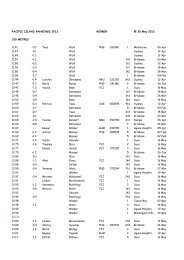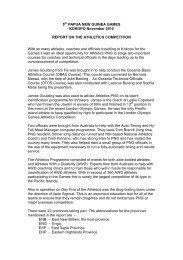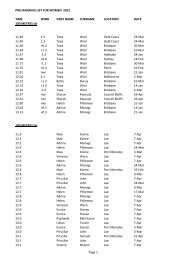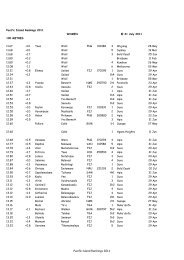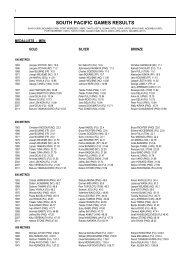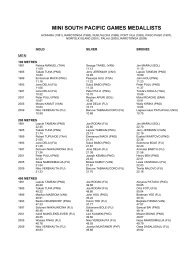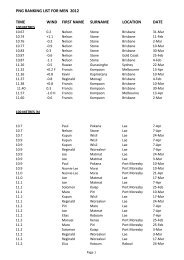pacific games, noumea 2011 - Oceania Athletics Association
pacific games, noumea 2011 - Oceania Athletics Association
pacific games, noumea 2011 - Oceania Athletics Association
You also want an ePaper? Increase the reach of your titles
YUMPU automatically turns print PDFs into web optimized ePapers that Google loves.
Injury Prevention<br />
By Richard Newsham-West PhD<br />
Griffith University , Gold Coast<br />
Participating in sport, while it has the associated health<br />
and psychological benefits, it does carry the risk of a<br />
musculoskeletal injury. Fortunately in track and field<br />
athletes, most injuries are not serious and the injury will<br />
rapidly repair and the athlete will rehabilitate quickly.<br />
Of all the track and field athletes the literature would<br />
suggest that the risk for injury is higher in athletes<br />
competing in the running events when compared to<br />
those competing in field events, but this is in no way<br />
conclusive. Epidemiological studies of injury prevalence,<br />
incidence and patterns in track and field athletics are<br />
scarce. What literature that does exist, suggests that in<br />
the running events where the foot hits the ground<br />
between 1000 and 1500 times per mile with forces of up<br />
to 3 times body weight, the overuse type injuries are<br />
common and occur mainly in the lower limb (leg and<br />
foot). In the events where a force is generated such as in<br />
the sprinting and jumping events acute muscular<br />
injuries are the most commonly reported injuries.<br />
Pole-vaulters and high jumpers tend to report acute<br />
lower back injuries as the predominant injury. In the<br />
throwing events, both acute and overuse upper limb and<br />
lower back injuries are reported. Knowing the<br />
predominant injury (type and body location) and<br />
knowledge in the cause of these injuries allows the team<br />
physiotherapist, coach and exercise physiologist to<br />
design event specific programs that are aimed at<br />
minimising the chance of these injuries occurring by<br />
addressing the risk factors associated or causes of the<br />
predominant injuries.<br />
Sports injuries are not often the result a single risk<br />
factor. Often they are a result of a number of intrinsic<br />
and extrinsic factors. Intrinsic or internal risk factors that<br />
may predispose the athlete to injury are factors that are<br />
individual and specific to that athlete, such as a muscle<br />
imbalance, prior injury, inadequate or poor diet, poor<br />
sleep or recovery and faulty mechanics. Risk factors that<br />
are external to the athlete include inappropriate or old<br />
footwear, their training practices and the physical<br />
environment in which they are training and compete in<br />
(e.g. the local climatic conditions).<br />
The healthcare provider associated with the team or<br />
squad should along with the coach and the athlete<br />
develop a plan for relevant prevention measures<br />
PHYSIOLOGY<br />
strategies that will not only minimise or remove these<br />
risk factors but better prepare the athlete for participation<br />
in their chosen event.<br />
A simple guide to injury prevention is as follows;<br />
Pre-season or pre-participation screening<br />
A healthcare provider, usually the physiotherapist will<br />
use a screening tool to identify the ‗at risk’ athlete and<br />
those factors that may increase the athlete to injury.<br />
This usually involves a full history of sporting activity<br />
and injury history, a physical examination, a measure<br />
muscle performance such as length and strength of<br />
the muscles (e.g. hamstring length, side bridging),<br />
proprioceptive or kinesthetic sense (balance) through<br />
a series of balance related assessments, a series of<br />
event specific skill based assessments and a series of<br />
fitness and conditioning assessments. During these<br />
assessments, deficits in the athlete‘s biomechanical<br />
and physiological systems that place the athlete at risk<br />
of injury can be identified and intervention(s) designed<br />
to address these can be introduced into the athletes<br />
training schedule.<br />
Warm-up, cool-down and stretch<br />
Warming-up correctly in important in preparing the<br />
body and mind for the activity is important in injury<br />
prevention. The cool-down is equally as important to<br />
help the body recover from exercise and again prevent<br />
injury. The warm-up should include a period of<br />
endurance and cardiovascular loading type exercises<br />
but also include skill or task specific exercises along<br />
with dynamic stretching to prepare the body for the<br />
demands of the sporting event. Cool down exercises is<br />
often forgotten by the athlete but it is equally<br />
important. It is important to perform some low impact<br />
low cardiovascular activity such as a light jog or walk,<br />
static stretches and re-fuelling with appropriate food<br />
and fluids. Some athletes use other recovery<br />
strategies such as massage, pool sessions and or<br />
contrast baths. These need to be explored by each<br />
individual athlete in consultation with their coaches.<br />
<strong>Oceania</strong> RDC Bulletin <strong>2011</strong> Page 14



